Second Italian War of Independence
The Second Italian War of Independence, also called the Franco-Austrian War, the Austro-Sardinian War or Italian War of 1859 (Italian: Seconda guerra d'indipendenza italiana; French: Campagne d'Italie),[3] was fought by the French Empire and the Kingdom of Sardinia against the Austrian Empire in 1859 and played a crucial part in the process of Italian unification.
| Second Italian War of Independence | |||||||||
|---|---|---|---|---|---|---|---|---|---|
| Part of the wars of Italian unification | |||||||||
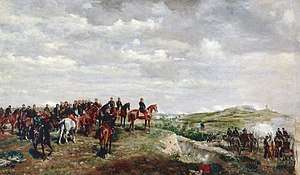 Napoleon III at the Battle of Solferino, by Jean-Louis-Ernest Meissonier Oil on canvas, 1863 | |||||||||
| |||||||||
| Belligerents | |||||||||
|
Support: |
| ||||||||
| Commanders and leaders | |||||||||
|
|
| ||||||||
| Strength | |||||||||
|
312 guns 90 guns[1] |
198,000 824 guns | ||||||||
| Casualties and losses | |||||||||
|
1,128 missing 17,054 wounded 2,040 disease related deaths Total: 25,720 casualties 1,268 missing[2] Total: unknown |
12,568 killed[2] Total: unknown | ||||||||
The background to the war was the Plombières Agreement between France and Sardinia on 21 July 1858, in which they agreed to carve up Italy between them, and the Franco-Sardinian military alliance signed in January 1859. Sardinia mobilized its army on 9 March 1859, while Austria mobilized on 9 April. On 23 April, Austria delivered an ultimatum to Sardinia, demanding Sardinia's demobilization. Upon Sardinia's refusal, the war began on 26 April. Austria invaded the Kingdom of Sardinia on 29 April and France declared war on Austria on 3 May.
The Austrian invasion was stopped by the arrival of French troops in Piedmont from 25 April onward. The Austrians were defeated at the Battle of Magenta on 4 June and pushed back to Lombardy, where the Franco-Sardinian victory at the Battle of Solferino on 24 June resulted in the end of the war and the signing of the Armistice of Villafranca on 12 July.
Austria ceded Lombardy to France, which in turn gave it to Sardinia. Sardinia exploited the defeat of Austrian power by annexing the United Provinces of Central Italy, consisting of the Grand Duchy of Tuscany, the Duchy of Parma, the Duchy of Modena and Reggio and the Papal Legations, to the Kingdom of Sardinia on 22 March 1860. Sardinia handed Savoy and Nice over to France at the Treaty of Turin on 24 March 1860.
Background
The Piedmontese, following their defeat by Austria in the First Italian War of Independence, recognised their need for allies. That led Camillo Benso, Count of Cavour, the prime minister of the Kingdom of Piedmont-Sardinia, to attempt to establish relations with other European powers, partially through Piedmont's participation in the Crimean War. In the peace conference at Paris after the Crimean War, Cavour attempted to bring attention to efforts for Italian unification. He found Britain and France to be sympathetic but entirely unwilling to go against Austrian wishes, as any movement towards Italian independence would necessarily threaten Austria's territory of Lombardy–Venetia. Private talks between Napoleon III and Cavour after the conference identified Napoleon as the most likely, albeit still uncommitted, candidate for aiding Italy.
On 14 January 1858, Felice Orsini, an Italian, led an attempt on Napoleon III's life. The assassination attempt brought widespread sympathy for the Italian unification effort and had a profound effect on Napoleon III himself, who now was determined to help Piedmont against Austria to defuse the wider revolutionary activities that governments in Italy might later allow to happen. After a covert meeting at Plombières on 21 July 1858, Napoleon III and Cavour on 28 January 1859 signed a secret treaty of alliance against Austria: France would help Sardinia-Piedmont to fight against Austria if attacked, and Sardinia-Piedmont would then give Nice and Savoy to France in return. The secret alliance served both countries: it helped with the Sardinian (Piedmontese) plan of unification of the Italian peninsula under the House of Savoy, and it weakened Austria, a fiery adversary of Napoleon III's French Second Empire.
Cavour, being unable to get the French help unless the Austrians attacked first, provoked Vienna with a series of military maneuvers close to the border. Sardinia mobilized its army on 9 March 1859. Austria mobilized on 9 April 1859 and issued an ultimatum on 23 April, demanding the complete demobilization of the Sardinian army. When it was not heeded, Austria started a war with Sardinia on 26 April. The first French troops entered Piedmont on 25 April, and France declared war on Austria on 3 May.[4]
Forces
The French army for the Italian campaign had 170,000 soldiers, 2,000 horsemen and 312 guns, half of the whole French army. The army was under the command of Napoleon III, divided into five corps: the I Corps, led by Achille Baraguey d'Hilliers, the II Corps, led by Patrice MacMahon, the III Corps, led by François Certain de Canrobert, the IV Corps, led by Adolphe Niel, and the V Corps, led by prince Napoleon. The Imperial Guard was commanded by Auguste Regnaud de Saint-Jean d'Angély.
The Sardinian army had about 70,000 soldiers, 4,000 horsemen and 90 guns. It was divided into five divisions, led by Castelbrugo, Manfredo Fanti, Giovanni Durando, Enrico Cialdini, and Domenico Cucchiari. Two volunteer formations, the Cacciatori delle Alpi and the Cacciatori degli Appennini, were also present. The commander in chief was Victor Emmanuel II of Savoy, supported by Alfonso Ferrero la Marmora.
The Austrian army fielded more men: it was composed of 220,000 soldiers, 824 guns and 22,000 horsemen and was led by Field Marshal Ferenc Graf Gyulay.
The newly-formed United Principalities also supported the Franco-Italian alliance. The Romanian ruler, Alexandru Ioan Cuza, was gifted by Napoleon III with 10,000 rifles and ammunition. Napoleon III - with his unwavering and very genuine sympathy for the Romanian cause - also sent a military mission to Bucharest. Encouraged, Cuza formed a new military camp at Ploiești. As a result, Austria was obliged to keep 30,000 troops in Transylvania, which could ill be spared from Italy.[5]
Operations

The French Army under Marshal François Certain Canrobert moved into Piedmont in the first massive military use of railways. The Austrian forces counted on a swift victory over the weaker Sardinian army before French forces could arrive in Piedmont. However, Count Gyulai, the commander of the Austrian troops in Lombardy, was very cautious and marched around the Ticino River in no specific direction until eventually, he crossed it to begin the offensive. Unfortunately for him, very heavy rains began to fall, allowing the Piedmontese to flood the rice fields in front of his advance, slowing his army's march to a crawl.
.jpg)
The Austrians, under Gyulai, captured Novara on 30 April and Vercelli on 2 May, and advanced on Turin from 7 May onward. The Franco-Sardinian move to strengthen the Alessandria and Po River bridges around Casale Monferrato forced the Austrians to halt their advance on 9 May and fall back on 10 May. Napoleon III left Paris on 10 May, landed at Genoa on 12 May and arrived in Alessandria on 14 May, taking the command of the operations. The first major clash of the war was at Montebello on 20 May, a battle between an Austrian Corps under Stadion and a single division of the French I Corps under Forey. The Austrian contingent was three times as large, but the French were victorious, making Gyulai still more cautious. In early June, Gyulai had advanced to the rail centre of Magenta, leaving his army spread out. Napoleon III attacked the Ticino head on with part of his force while sending another large group of troops to the north to flank the Austrians. The plan worked, causing Gyulai to retreat east to the quadrilateral fortresses in Lombardy, where he was relieved of his post as commander.
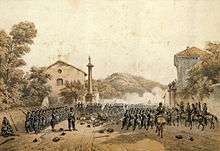

Replacing Gyulai was Emperor Franz Josef I himself. He planned to defend the well-fortified Austrian territory behind the Mincio River. The Piedmontese-French army had taken Milan and slowly marched further east to finish off Austria in this war before Prussia could get involved. The Austrians found out that the French had halted at Brescia, and decided that they should counterattack along the river Chiese. The two armies met accidentally around Solferino, precipitating a confused series of battles. A French corps held off three Austrian corps all day at Medole, keeping them from joining the larger battle around Solferino, where, after a day-long battle, the French broke through. Ludwig von Benedek with the Austrian VIII Corps was separated from the main force, defended Pozzolengo against the Piedmontese part of the opposing army. This they did successfully, but the entire Austrian army retreated after the breakthrough at Solferino, withdrawing back into the Quadrilateral.[6]
At the same time, in the northern part of Lombardy, the Italian volunteers of Giuseppe Garibaldi's Hunters of the Alps defeated the Austrians at Varese and Como and the Piedmontese-French navy landed 3,000 soldiers and conquered the islands of Losinj (Lussino) and Cres (Cherso) in Dalmatia.[7]
Peace
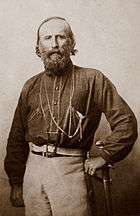
Napoleon III signed the Villafranca Armistice with Austria in Villafranca for a combination of reasons: Napoleon III was not the conqueror that his uncle had been and could not stomach the sight of war; the Austrians had retreated to The Quadrilateral, which would be very costly to overrun; Napoleon III's absence in France made them vulnerable to attack; Napoleon III's actions in Italy were being criticized in France; Napoleon III did not want Cavour and Piedmont to gain too much power, mostly at the expense of Napoleon III's men; and Napoleon III's fear of involvement by the German states. Most of Lombardy, with its capital, Milan (excepting only the Austrian fortresses of Mantua and Legnago and the surrounding territory), was transferred from Austria to France, which would immediately cede the territories to Sardinia. The rulers of Central Italy, who had been expelled by revolution shortly after the beginning of the war, were to be restored.
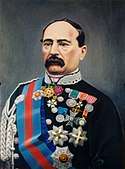
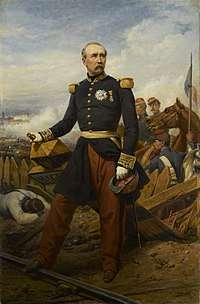
The deal, made by Napoleon behind the backs of his Sardinian allies, led to great outrage in Sardinia-Piedmont, and Cavour himself resigned in protest. However, the terms of Villafranca were never to come into effect. Although they were reaffirmed by the final Treaty of Zürich in November, the agreement had by then become a dead letter. The central Italian states were occupied by the Piedmontese, who showed no willingness to restore the previous rulers, and the French showed no willingness to force them to abide by the terms of the treaty. The Austrians were left to look on in frustration at the French failure to carry out the terms of the treaty. While Austria had emerged triumphantly after the suppression of liberal movements in 1849, its status as a great power on the European scene was now seriously challenged, and its influence in Italy severely weakened.
The next year, with French and British approval, the central Italian states (Duchy of Parma, Duchy of Modena, Grand Duchy of Tuscany and the Papal States) were annexed by the Kingdom of Sardinia, and France would take its deferred reward: Savoy and Nice. The last move was vehemently opposed by Italian national hero Garibaldi, a native of Nice, and directly led to Garibaldi's expedition to Sicily, which would complete the preliminary Unification of Italy.[8]
During the war, Prussia also mobilised 132,000 men in 1859 but never joined the fighting. The weaknesses laid bare during the mobilisation caused the Prussian army to initiate military reforms,[9] which were the base for its superiority and rapid victories against Austria 1866 and France 1870/1 leading to a united Germany under Prussian dominance.[10]
Timeline
- 27 April: A peaceful revolution in Tuscany ousts Archduke Leopold II and installs a provisional government
- 20 May: French infantry and Sardinian cavalry defeat the Austrian army, which retreated, near Montebello.
- 26 May: Garibaldi's Hunters of the Alps confront Austrian forces led by Field Marshal-Lieutenant Carl Baron Urban at Varese.
- 27 May: Hunters of the Alps defeat Urban at San Fermo, entering Como.
- 30 May: French and Sardinian forces defeat the Austrian army at the Battle of Palestro.
- 4 June: In the Battle of Magenta, the French defeat Austrians.
- 21 June/24 June: In the Battle of Solferino, Sardinians and Napoleon III of France defeat an army commanded by Emperor Franz Joseph of Austria himself in northern Italy. The battle inspires Henri Dunant to found the Red Cross.
- 11 July: Franz Joseph, faced with the revolution in Hungary , meets Napoleon III at Villafranca, where they signed an armistice.
References
- Micheal Clodfelter. "Warfare and Armed Conflicts: A Statistical Reference to Casualty and Other Figures, 1500–2000", 4th Edition. 2017. Page 181.
- Clodfelter, p. 181
- Arnold Blumberg, A Carefully Planned Accident: The Italian War of 1859 (Cranbury, NJ: Associated University Presses, 1990); Arnold Blumberg, "Russian Policy and the Franco-Austrian War of 1859", The Journal of Modern History, 26, 2 (1954): 137–53; Arnold Blumberg, The Diplomacy of the Austro-Sardinian War of 1859, Ph.D. diss. (Graduate School of Arts and Sciences, University of Pennsylvania, 1952).
- "Second War of Italian Independence, 1859–61". www.historyofwar.org. Retrieved 30 March 2018.
- R. W. Seton-Watson, Cambridge University Press, May 21, 2015, A History of the Roumanians, pp. 302-303
- Administrator. "La Seconda guerra d'indipendenza". www.150anni-lanostrastoria.it. Retrieved 30 March 2018.
- Luigi Tomaz, In Adriatico nel secondo millennio, Presentazione di Arnaldo Mauri, Think ADV, Conselve, 2010, p. 411.
- Sapere.it. "La seconda Guerra d'Indipendenza e la spedizione dei Mille – Sapere.it". www.sapere.it. Retrieved 30 March 2018.
- Engels, Friedrich; Preußische Militärfrage und die Deutsche Arbeiterpartei; Hamburg 1865 (Meißner); reprint Berlin 1974 (Dietz).
- Lohner, Henry; Wie wird man schnell reich?; Norderstedt 2011; S. 78; ISBN 978-3-8423-7334-1
Further reading
- Blumberg, Arnold. A Carefully Planned Accident: The Italian War of 1859 (Susquehanna University Press. 1990). Pp. 238.
- Bossoli, Carlo . The War in Italy: the Second Italian War of Independence, 1859 (1860), illustrated; online free
- Carter, Nick. "Hudson, Malmesbury and Cavour: British Diplomacy and the Italian Question, February 1858 to June 1859." Historical Journal 40#2 (1997): 389–413. in JSTOR
- Coppa, Frank J. The origins of the Italian wars of independence (1992).
- Schneid, Frederick C. The Second War of Italian Unification 1859–61 (Bloomsbury Publishing, 2012).
- Thayer, William Roscoe (1911). The Life and Times of Cavour vol 1. old interpretations but useful on details; vol 1 goes to 1859; volume 2 online covers 1859–62
.jpg)